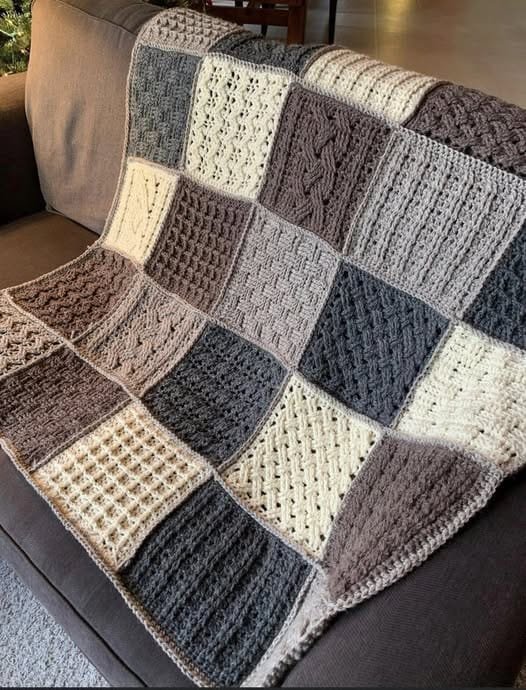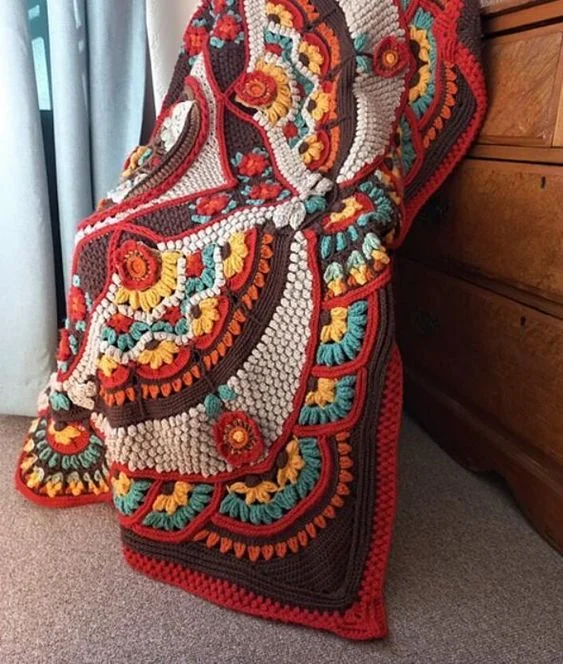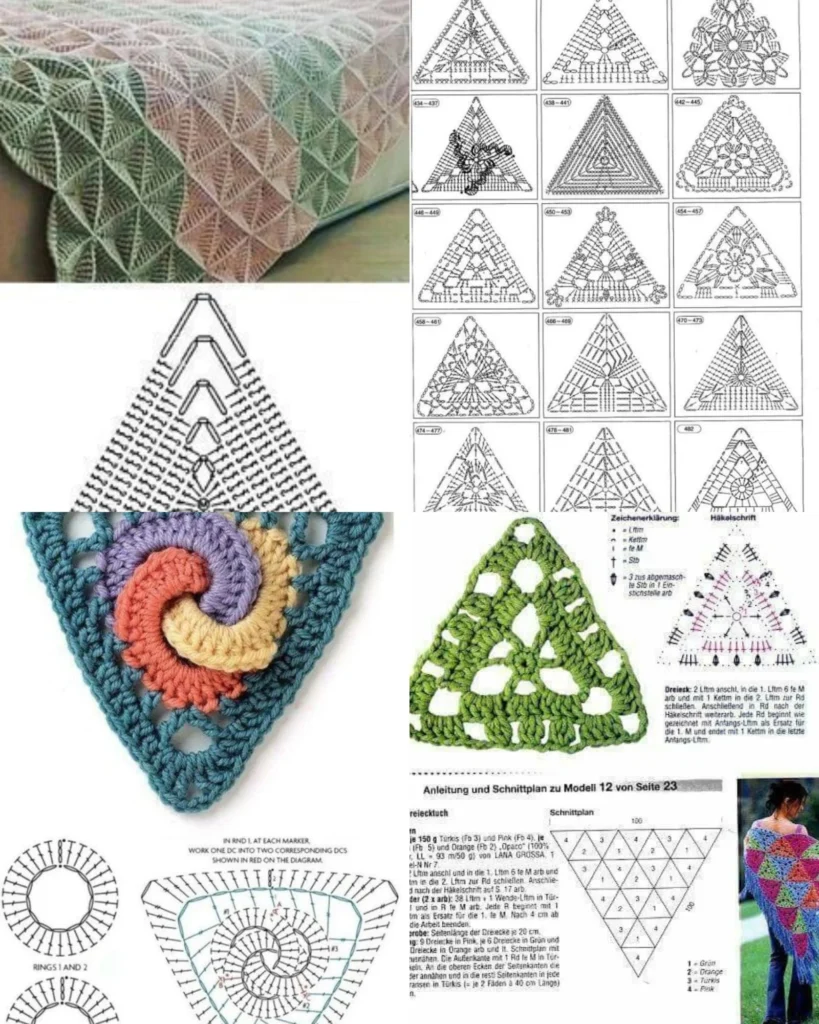Creating a Textured Crochet Blanket Pattern is one of the most rewarding experiences in the crochet world. Not only does it offer warmth and comfort, but it also adds a touch of artistry and personal expression to your home. Whether you’re a beginner or a seasoned crocheter, learning how to work with texture opens the door to a wide variety of beautiful and tactile designs that go beyond basic stitches.
The charm of a textured crochet blanket lies in its intricate surface. Using a combination of stitches such as bobbles, puffs, cables, and raised post stitches, you can transform a simple project into a rich visual and tactile experience. This kind of blanket becomes more than a craft—it becomes a statement piece, an heirloom, or a heartfelt gift. It’s the type of project people admire and love to touch.
In this article, we’ll explore the essential techniques behind a Textured Crochet Blanket Pattern, how to choose the right yarn and tools, tips to maintain uniform texture, and creative ideas to personalize your design. Whether you’re making a baby blanket, a lapghan, or a full-sized throw, this guide will equip you with everything you need to start or improve your textured creations.

Understanding Texture in Crochet: Techniques and Stitch Patterns
Texture in crochet is achieved by combining certain stitches that rise above the base layer of fabric. These stitches catch the light differently and add dimension, making the blanket more visually appealing and enjoyable to feel. Learning these techniques is key to mastering any Textured Crochet Blanket Pattern.
One popular technique is the front post double crochet. This stitch wraps around the post of a stitch instead of through the top loops, pulling it forward and creating a ribbed or raised effect. It’s frequently used in cable and basketweave patterns.
The bobble stitch is another favorite among textured crochet designs. It involves working several double crochets together in the same stitch, then closing them to form a raised lump. Bobbles can be used to create floral effects, words, or geometric patterns.
The puff stitch is similar but softer, with yarn overs and incomplete pulls that are finally closed together. Puffs provide a plush, pillowy texture that’s great for baby blankets or cozy throws.
Another powerful texture tool is the popcorn stitch, which creates round, bubble-like forms that pop out from the fabric. These are perfect for borders or accent rows in your textured crochet blanket.
Crossed stitches and cable patterns add a unique look as well, simulating the appearance of woven threads. These are often used in more advanced blanket designs but are well worth learning for the dramatic texture they produce.
Lastly, cluster stitches group several stitches into one base to create a thick, dimensional shape. Clusters are a staple in many Textured Crochet Blanket Patterns and can be adapted in countless ways.
Choosing the Right Yarn and Hook for Texture
Selecting the appropriate materials is essential when working on a Textured Crochet Blanket Pattern. The right yarn will enhance your stitch definition, while the correct hook size will affect the depth and appearance of your textures.
When it comes to yarn, opt for smooth, solid-colored, worsted or aran-weight yarns. These yarns highlight texture better than variegated or fuzzy options like mohair or boucle, which can hide stitch definition. Cotton and cotton-blend yarns also work beautifully for structured textures.
Avoid very dark colors for highly textured patterns, as they tend to obscure the detail of your work. Neutrals, pastels, and bright solids showcase textured stitches with clarity and elegance.
The size of your crochet hook can also change the look of your blanket. A slightly smaller hook than recommended for your yarn weight will tighten your stitches and help your texture stand out. However, going too small can make your blanket stiff and reduce drape, so strike a balance.
For best results, make a swatch first. Test a few rows of your chosen Textured Crochet Blanket Pattern using the yarn and hook you plan to work with. Feel the texture, examine the stitch clarity, and adjust as needed.
Using ergonomic hooks can make the process much more comfortable, especially since textured crochet often involves more wrist movement due to complex stitch combinations.
Always check your gauge, even for blankets. While exact size may not be crucial, consistency ensures your stitches look even and your blanket lays flat.
Finally, don’t forget to use stitch markers, especially in complex rows. They can help you track pattern repeats and make your crochet experience much smoother.
Tips for Maintaining Consistency and Structure
Once you’ve chosen your Textured Crochet Blanket Pattern, keeping the stitch consistency and structure uniform is crucial to achieving a professional finish. Texture-heavy blankets can become distorted if tension fluctuates or if stitches aren’t aligned properly.
Always maintain even tension. When working raised stitches like bobbles or popcorns, it’s common to pull too tightly or too loosely. Practice keeping the same yarn flow for each stitch, which will help the texture stay consistent throughout the blanket.
Count your stitches often. Texture patterns can be tricky to read, and it’s easy to accidentally add or skip stitches. Counting at the end of each row or section will save you from major frogging later.
Use blocking techniques after finishing your blanket to help even out the shape and texture. Wet blocking or steam blocking can do wonders, especially if some areas are tighter due to complex stitches.
If your pattern includes repeats, write them down or highlight them to avoid confusion. Working with textured stitches often means following a set rhythm, and visual aids can keep you on track.
Take breaks when needed. Textured crochet can be physically demanding due to its repetitive and sometimes tight stitches. Give your hands and wrists time to rest, especially during longer sessions.
And finally, enjoy the process. Each stitch in your Textured Crochet Blanket builds a story. Don’t rush; the beauty of texture lies in its detail and depth.
Adding Your Personal Touch: Customization and Finishing Ideas
One of the best things about making a Textured Crochet Blanket is the opportunity to personalize your work. You can take a simple pattern and turn it into something uniquely yours by adding creative modifications.
Consider color blocking sections of texture. For example, you can alternate rows of bobbles with puff stitches in different colors for a bold, modern look. Or you can make each textured section a different tone of the same color family for a subtle ombré effect.
Borders are another great place to customize. You can keep it simple with a single-crochet edge or add flair with a scalloped or picot finish. A wide border using the same textured stitches as the center can also unify your design beautifully.
Add initials, symbols, or images using bobble stitch patterns. This adds a personal touch, perfect for gifts or commemorative pieces.
Mix in different yarns. If you’re feeling bold, you can use textured yarns like chenille or velvet in specific rows to add even more dimension to your Textured Crochet Blanket Pattern. Just ensure the yarns are similar in weight to avoid warping.
Label your creation. You can sew on a small tag with your name, date, or a message. It’s a simple yet touching addition, especially if you’re giving the blanket as a gift.
Finally, take photos of your process. Not only will you have a keepsake of your progress, but you’ll also inspire others in the crochet community.
FAQ: Frequently Asked Questions About Textured Crochet Blanket Patterns
What is a textured crochet blanket?
A textured crochet blanket is a handmade blanket that uses stitches like bobbles, puffs, and cables to create a raised, three-dimensional look and feel. These blankets are both visually interesting and comforting to touch.
Is a textured crochet blanket good for beginners?
Yes, many Textured Crochet Blanket Patterns are beginner-friendly. Start with simple textures like front post double crochet or bobble stitch. As you gain confidence, you can explore more complex textures.
What yarn is best for a textured crochet blanket?
Worsted or aran-weight yarn in solid colors works best. Choose smooth fibers like cotton or acrylic that highlight the stitch definition. Avoid fuzzy or dark yarns that hide texture.
Do textured stitches use more yarn?
Yes, textured stitches often require more yarn than basic stitches like single or double crochet. Make sure to buy extra yarn—at least 10-20% more than a flat pattern might require.
How do I keep my blanket edges straight with textured stitches?
Count your stitches regularly and use stitch markers. Always work your turning chains consistently, and consider adding a simple border at the end to straighten the edges.
Can I mix different textured stitches in one blanket?
Absolutely! Mixing stitches like puff, bobble, and popcorn can create a rich and dynamic pattern. Just be sure to swatch and plan your layout to ensure balance and cohesion.
Do I need to block my textured crochet blanket?
Blocking helps even out tension and stitch definition, especially with intricate textures. Wet blocking or steam blocking is recommended for a polished look.
How long does it take to make a textured crochet blanket?
It depends on the size and complexity of the pattern. A lap-sized blanket might take 20-30 hours, while a full-size throw could take 50+ hours depending on your pace.
Is textured crochet suitable for baby blankets?
Yes, but choose softer stitches like puff or waffle that are gentle on the skin. Avoid sharp or overly bulky textures for babies to ensure comfort and safety.
What hook size should I use for a textured crochet blanket?
Use the size recommended for your yarn, or go down one size to enhance texture. Always swatch before starting your full project to test drape and definition.
Conclusion
A Textured Crochet Blanket Pattern is more than just a crochet project—it’s an opportunity to create something beautiful, functional, and uniquely yours. From understanding textured stitches and selecting the perfect yarn to maintaining consistency and adding personal touches, every step of the process is a chance to grow as a maker.
Whether you’re crafting for comfort, for decor, or for someone you love, a textured blanket brings warmth and joy in every stitch. Take your time, explore the patterns, and let your creativity guide you.



